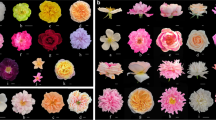Abstract—
A study of morphological traits in the populations of R. aureum from Western and Eastern Sayan and Kamchatka has been carried out. The variability of genetic nuclear DNA microsatellite markers (nSSRs) has been studied in the same samples. A total of 15 absolute and relative morphological traits of shoots and leaves, as well as 18 polymorphic microsatellite markers in eight natural populations of R. aureum, are observed. It is found that the following parameters are the most variable within species populations: plant size, shoot length, length of the foliated part of shoots, and number of leaves relative to shoot length; relative leaf shape parameters are more stable parameters. The reliable division of populations into three geographical groups on all set of morphological characters is established. One important taxonomic character, the leaf life span, is shown to make a great contribution on the shoot to the division of geographical groups of populations and individual populations. The structure of morphological differentiation of populations is confirmed by the results of the analysis of genetic variability of the same populations of R.aureum by nuclear microsatellite markers. The greatest genetic distances from other populations are established for the Kamchatka populations. There is a tendency toward the differentiation of populations within the Altai-Sayan mountain country. The results of the study agree well with the information on geography, ecology, and biology of the species. The study of intra- and interpopulation morphological differentiation of R. aureum populations in Siberia is conducted for the first time, following the recently initiated studies on genetic variability of the species in Northern Eurasia.




Similar content being viewed by others
REFERENCES
Aivazyan, S.A., Bezhaeva, Z.I., and Staroverov, O.V., Klassifikatsiya mnogomernykh nablyudenii (Classification of Multivariate Observations), Moscow, 1974.
Aleksandrova, M.S., Rododendrony prirodnoi flory (Rhododendrons of the Natural Flora of the USSR), Moscow, 1975.
Borovikov, V., STATISTICA. Iskusstvo analiza dannykh na komp’yutere (STATISTICA. The Art of Data Analysis on a Computer), St. Petersburg, 2003.
Devey, M.E., Bell, J.C., Smith, D.N., et al., A genetic linkage map for Pinus radiata based on RFLP, RAPD and microsatellite markers, Theor. Appl. Genet., 1996, vol. 92, pp. 673–679.
Gasheva, N.A., Experience in using discriminant analysis to distinguish phenotypically similar species of willows, Vestn. Ekol., Lesoved. Landshaftoved., 2006, no. 6, pp. 123–130.
Headrick, F., Genetika populyatsii (Genetics of Populatoins), Moscow: Tekhnosfera, 2003.
Kwak, M., Won, H., Hong, J., and Lee, B.Y., Isolation and characterization of 19 novel microsatellite loci in Rhododendron aureum and Rhododendron brachycarpum (Ericaceae), Biochem. Syst. Ecol., 2015, vol. 61, pp. 520–523.
Li, L.-F., Song, N., Tang, E.H., and Xiao, H.X., Genomic and EST microsatellites for Rhododendron aureum (Ericaceae) and cross-amplification in other congeneric species, Am. J. Bot., 2011, vol. 98, pp. 250–252.
Liu, Y.-F., Xing, M., Zhao, W., et al., Genetic diversity analysis of Rhododendron aureum Georgi (Ericaceae) located on Changbai Mountain using ISSR and RAPD markers, Plant. Syst. Evol., 2012, vol. 298, pp. 921–930.
Mamaev, S.A., Formy vnutrividovoi izmenchivosti drevesnykh rastenii (na primere sem. Pinaceae na Urale) (Forms of Intraspecific Variability of Woody Plants (on the Example of the Family Pinaceae in the Ural Mountains)), Moscow, 1973.
Mantel, N., The detection of disease clustering and a generalized regression approach, Cancer Res., 1976, vol. 27, pp. 209–220.
Olennikov, D.N., Dudareva, L.V., Osipenko, S.V., and Penzina, T.A., Chemical composition of Rhododendron aureum (Gold rosebay) essential oil from Pribaikal’e (Russian Federation), J. Serb. Chem. Soc., 2010, vol. 75, pp. 209–215.
Opredelitel’ rastenii yuga Krasnoyarskogo kraya (Key to Plants of the South of the Krasnoyarsk Region), Krasnoborov, I.M. and Kashina, L.I., Ed., Novosibirsk. 1979.
Peakall, R. and Smouse, P.E., GENALEX 6: genetic analysis in Excel. Population genetic software for teaching and research, Mol. Ecol. Notes, 2006, vol. 6, pp. 288–295.
Poyarkova, A.I., Genus Rhododendron, Flora SSSR (Flora USSR), Moscow, 1952, pp. 31–60.
Rostova, N.S., Correlative and multivariate analysis; application in population studies, Materialy H Vserossijskogo populyacionnogo seminara “Sovremennoe sostoyanie i puti razvitiya populyatsionnoi biologii” (Proc. X All-Russ. Popul. Semin. “Current State and Ways of Development of Population Biology”), Izhevsk, 2008, pp. 51–56.
Shmidt, V.M., Matimaticheskie metody v biologii (Mathematical Methods in Biology), Leningrad: Leningrad. Gos. Univ., 1984.
Tan, X.X., Li, Y., and Ge, X.J., Development and characterization of eight polymorphic microsatellites for Rhododendron simsii Planch (Ericaceae), Conserv. Genet., 2009, vol. 10, pp. 1553–1555.
Tikhonova, N.A., Intra- and interpopulation variation of leaf life span in Rhododendron ledebourii Pojark. and Rh. dauricum L. (Ericaceae Juss.) and its environmental determination, Russ. J. Ecol., 2019, vol. 50, no. 4, pp. 323–330.
Wang, X.Q., Huang, Y., and Long, C.L., Assessing the genetic consequences of flower-harvesting in Rhododendron decorum Franchet (Ericaceae) using microsatellite markers, Biochem. Syst. Ecol., 2013, vol. 50, pp. 296– 303.
Wang, X., Lin, L., Zhao, W., et al., Rhododendron aureum Georgi formed a special soil microbial community and competed with above-ground plants on the tundra of the Changbai Mountain, China, Ecol. Evol., 2017, vol. 7, pp. 7503–7514.
ACKNOWLEDGMENTS
We are grateful to Cand. Sci. (Biol.) V.P. Vetrova for assistance in sampling.
Funding
This study was conducted as part of the State Task of the Institute of Forest, Siberian Branch, Russian Academy of Sciences, no. 122022600013-5. The molecular genetic analysis was carried out as part of the State Task of the Institute of Plant and Animal Ecology, Ural Branch, Russian Academy of Sciences, no. 122021000090-5.
Author information
Authors and Affiliations
Corresponding author
Ethics declarations
Conflict of interests. The authors declare that they have no conflict of interest.
Statement on the welfare of animals. All applicable international, national, and/or institutional guidelines for the care and use of animals were followed.
Additional information
Translated by N. Ruban
Rights and permissions
About this article
Cite this article
Tikhonova, N.A., Polezhaeva, M.A. Morphological and Genetic Differentiation of Populations of Rhododendron aureum Georgi. (Ericaceae) in the Mountains of Southern Siberia and on the Kamchatka Peninsula. Contemp. Probl. Ecol. 16, 575–582 (2023). https://doi.org/10.1134/S1995425523050141
Received:
Revised:
Accepted:
Published:
Issue Date:
DOI: https://doi.org/10.1134/S1995425523050141




